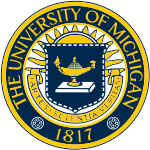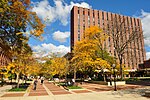University of Michigan

The University of Michigan (U-M, UMich, or simply Michigan) is a public research university in Ann Arbor, Michigan. Founded in 1817, it is the oldest institution of higher education in the state. The University of Michigan is one of the earliest American research universities and is a founding member of the Association of American Universities. In the fall of 2023, the university enrolled over 52,000 students. The university is classified among "R1: Doctoral Universities – Very High Research Activity". It consists of nineteen colleges and offers 250 degree programs at the undergraduate and graduate level across various liberal arts and STEM disciplines. The university is accredited by the Higher Learning Commission. In 2021, it ranked third among American universities in research expenditures according to the National Science Foundation. The University of Michigan's athletic teams are collectively known as the Wolverines. They compete in NCAA Division I FBS as members of the Big Ten Conference. The university currently fields varsity teams across 29 NCAA-sanctioned sports. As of 2022, athletes from the university have won 188 medals at the Olympic Games. Notable alumni from the university include 8 domestic and foreign heads of state or heads of government, 47 U.S. senators, 218 members of the U.S. House of Representatives, 42 U.S. Cabinet secretaries, and 41 U.S. governors.
Excerpt from the Wikipedia article University of Michigan (License: CC BY-SA 3.0, Authors, Images).University of Michigan
South State Street, Ann Arbor
Geographical coordinates (GPS) Address Nearby Places Show on map
Geographical coordinates (GPS)
| Latitude | Longitude |
|---|---|
| N 42.276944444444 ° | E -83.738055555556 ° |
Address
South State Street 500
48109 Ann Arbor
Michigan, United States
Open on Google Maps











